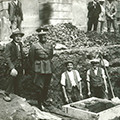The Restoration of Prague Castle 1918-1929
Theresian Wing of the Old Royal Palace, Prague Castle, Prague 1 – Hradčany
October 18, 2017 - May 6, 2018
|
The Restoration of Prague Castle 1918-1929Theresian Wing of the Old Royal Palace, Prague Castle, Prague 1 – HradčanyOctober 18, 2017 - May 6, 2018
In 2018, we will commemorate the hundredth anniversary of the foundation of the Czechoslovak Republic. One of its main symbols was Prague Castle, which became the seat of the presidents of Czechoslovakia and the Czech Republic. The renovation of Prague Castle started in the autumn of 1918 and called for vast building-historical and archaeological research that is connected mainly with the names Kamil Hilbert, Karel Fiala, and Ivan Borkovský, the latter’s 120th birthday anniversary is celebrated this year. The results of the research and surveys influenced both the architects, mainly Josip Plečnik, and the artists working at Prague Castle, by which way they were integrated into the castle’s new symbolism. These surveys made use of at the time very progressive methods and it is safe to say that Kamil Hilbert laid the foundations of the tradition of building-historical surveys in Czechoslovakia and of medieval archaeology. The large interventions into the castle’s architecture did not arouse only enthusiasm, but also general debates and even protests by experts and the lay public. All this is the subject of the present exhibition, which is divided into seven sections: The first one is dedicated to the appearance of the castle before the start of large construction projects in 1918. The second section presents Kamil Hilbert’s concept of the use of Prague Castle for the needs of the newly established state immediately after its foundation. This is followed by a look at the relation of both the experts and lay public to the castle and at the main subjects of contemporary debates on this restoration. The project of President Masaryk’s apartment is subject of the fourth section. The two last sections present the archaeological research and building-historical surveys; a separate part is devoted to the completion of the cathedral. The sections include the premier exhibition of a A number of archaeological finds: the log cabins and Romanesque architectural elements from the Basilica of St Vitus, stained glass that was removed from St Wenceslas’ Chapel in the 1920 and has now been restored, casts of important architectural elements mounted in 1920s or models of some of Plečnik’s building projects. In the course of the exhibition, we will add a model of the South Gardens before 1918 and a 3D model of the excavations beneath the Third Courtyard. The exhibition, however, focuses on a vast sample of archival material, historic records, and photographs. Jana Maříková-Kubková |


